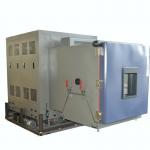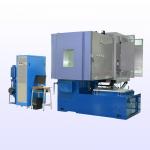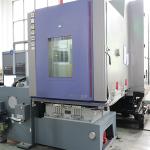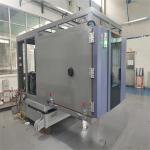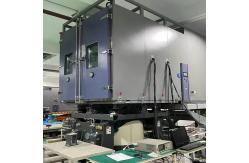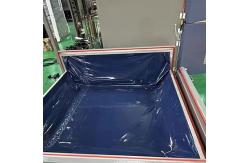In the world of laboratory testing and product quality assurance,
the Temperature Humidity Vibration Combined Climatic Test Chamber
is a powerful and indispensable tool. It is designed to subject
various specimens and products to a comprehensive range of
environmental conditions, simulating the real-world stresses they
might encounter during their lifecycle. The Temperature Humidity Vibration Combined Climatic Test Chamber
is a specialized apparatus used to conduct combined tests of
temperature, humidity, and vibration on a wide variety of samples.
It finds extensive application in industries such as electronics,
automotive, aerospace, and materials research. By precisely
controlling and varying temperature, humidity levels, and applying
vibration simultaneously or in sequence, it enables the evaluation
of how products or materials respond and perform under different
environmental stressors. This information is crucial for ensuring
the reliability, durability, and quality of products, helping
manufacturers to identify potential weaknesses and make
improvements before the products reach the market. - Robust and Controlled Testing Environment
- The chamber is constructed from high-quality stainless steel or
other corrosion-resistant materials, ensuring its durability and
resistance to the harsh conditions within. It is engineered to
provide a highly sealed and insulated space, allowing for accurate
control of temperature and humidity. The interior is designed with
smooth surfaces to prevent any condensation or ice formation that
could affect the test results. The chamber is equipped with a
powerful refrigeration system, heating elements, and
humidification/dehumidification devices, all of which are precisely
calibrated and controlled by an advanced computerized control
system.
- The vibration system is a key component of the chamber. It
typically consists of an electromechanical shaker or a hydraulic
actuator that can generate a wide range of vibration frequencies
and amplitudes. The vibration table is mounted within the chamber
and is designed to have a high load-bearing capacity and excellent
vibration isolation to ensure that the vibrations are accurately
transmitted to the test sample without interference from external
sources.
- Precision Instrumentation and Measurement Capabilities
- The test chamber is fitted with a suite of high-precision sensors.
Temperature sensors with a high degree of accuracy and rapid
response time are used to monitor and control the temperature
within the chamber, typically with an accuracy of ±0.1°C. Humidity
sensors, often capacitive or resistive types, measure the relative
humidity levels with an accuracy of ±2% RH. The vibration sensors,
such as accelerometers, can accurately measure the vibration
amplitudes, frequencies, and acceleration levels applied to the
sample.
- The data acquisition system is capable of recording and storing all
the measured parameters in real-time. It can generate detailed
reports and graphs that provide a comprehensive analysis of the
sample's performance under the combined environmental stresses. The
control system allows for easy programming and setting of different
test profiles, enabling the simulation of complex environmental
scenarios.
- Flexible and Customizable Testing Modes
- The chamber offers a variety of testing modes. It can conduct
single-factor tests, such as only temperature cycling, humidity
exposure, or vibration testing, to isolate and study the effect of
each individual environmental factor. Additionally, it can perform
combined tests where temperature, humidity, and vibration are
applied simultaneously or in a specific sequence. For example, a
product might be subjected to a high-temperature and high-humidity
environment while being vibrated at a certain frequency, mimicking
the conditions it could face during transportation in a tropical
region. The testing parameters, including temperature range
(typically from -70°C to +150°C), humidity range (from 10% to 98%
RH), and vibration parameters (frequencies from 5 Hz to 2000 Hz and
amplitudes up to several millimeters), can be adjusted according to
the specific requirements of the test and the product being
evaluated.
| Product name | Temperature Humidity Vibration Combined Climatic Test Chamber | | Humi.Range | 10%Rh~98%Rh | | Computer Interface | RS-232c,USB | | Frequency Range | 1-3000Hz | | Control | Vibration,Cross-Temperature&Humidity | | Displacement | 100mm | | Rate Force | 2000kgf | | Temp. Range | 0°C -20°C -40°C -70°C~150 °C | | Temperature Falling Speed | 0.1~1.5°C/Min | | Temperature Rising Speed | 0.1~3.0°CMin | | Certification | ISO |
- Accurate Environmental Stress Evaluation
- The primary function of the Temperature Humidity Vibration Combined
Climatic Test Chamber is to provide a detailed and accurate
assessment of how products or materials respond to a combination of
environmental stresses. By precisely controlling and measuring
temperature, humidity, and vibration, it determines the effects on
the physical, chemical, and mechanical properties of the sample.
For instance, in the electronics industry, it can reveal if a
circuit board will experience solder joint failures or component
degradation under specific temperature and vibration conditions.
This helps manufacturers to optimize their product designs and
select more suitable materials to enhance durability.
- The measurement of various parameters during the test also aids in
understanding the failure mechanisms. It can identify whether a
material cracks due to thermal stress, corrodes in a humid
environment, or fails structurally under vibration. This knowledge
is invaluable for improving product quality and reliability.
- Compliance with Industry Standards and Regulations
- Many industries are subject to strict standards and regulations
regarding product quality and environmental testing. The test
chamber is a reliable tool for ensuring compliance. For example, in
the automotive industry, products must meet certain standards for
temperature and vibration resistance to ensure their performance
and safety during operation. By using this chamber to conduct tests
in accordance with relevant standards such as ISO, IEC, or
automotive-specific standards, manufacturers can prove that their
products meet the necessary requirements, facilitating market
access and enhancing consumer confidence.
- Regulatory bodies also rely on the accurate test results obtained
from this equipment to enforce safety and quality regulations. It
serves as a dependable means for inspectors and certifying agencies
to determine the suitability of products for use in different
applications.
- Research and Development Support
- In the field of research and development, the chamber is an
invaluable asset. It allows scientists and engineers to study the
effects of different environmental conditions on new materials and
product prototypes. For example, in the development of new
polymers, the chamber can be used to evaluate how changes in
temperature and humidity affect their mechanical properties and
durability. This helps in optimizing the formulation and processing
of materials to achieve better performance.
- The detailed data provided by the test chamber serves as a roadmap
for innovation. It enables researchers to explore new design
concepts and materials that can better withstand complex
environmental stresses, leading to the development of more advanced
and reliable products.
- Stringent Manufacturing Process
- The Temperature Humidity Vibration Combined Climatic Test Chamber
is manufactured under strict quality control procedures. Each
component, from the refrigeration unit to the vibration shaker and
the sensors, is carefully sourced and inspected for quality and
performance. The assembly process is carried out by highly trained
technicians in a clean and controlled environment, ensuring the
proper alignment and functionality of all parts.
- The calibration of the temperature, humidity, and vibration
measurement systems is a critical and regular part of the
manufacturing process. It is performed using traceable reference
standards to guarantee the accuracy and reproducibility of the test
results. Rigorous quality audits and inspections are conducted at
various stages of production to maintain the highest level of
product quality.
- Quality Certification and Validation
Our test chamber has obtained relevant quality certifications and
has been validated by independent testing laboratories. It has been
proven to provide accurate and reliable test results, conforming to
the relevant international and national standards. We also
continuously update and improve our product based on the latest
technological advancements and customer feedback to ensure its
long-term performance and compliance.
- Electronics Industry
- A leading electronics manufacturer used the Temperature Humidity
Vibration Combined Climatic Test Chamber to test a new generation
of smartphone components. The test results showed that a particular
type of connector had a tendency to loosen under a combination of
high temperature and vibration. By redesigning the connector and
using more suitable materials, they were able to improve the
product's reliability and reduce the number of field failures. The
company's reputation for quality was enhanced, and they gained a
competitive edge in the market.
- An electronics research institution utilized the chamber to study
the long-term stability of new semiconductor materials. The data
obtained helped them develop a new manufacturing process that
improved the material's resistance to environmental stress, leading
to the production of more durable and efficient semiconductors.
- Automotive Industry
- An automotive parts manufacturer used the test chamber to evaluate
the performance of a new engine control unit (ECU). The combined
environmental testing revealed that the ECU had issues with its
circuitry in a high-humidity and vibration environment. They were
able to make design changes and improve the sealing and component
layout, resulting in a more reliable ECU that met the strict
automotive industry standards.
- A major automotive manufacturer used the chamber to test the
durability of their vehicle interiors. By subjecting the materials
to temperature, humidity, and vibration cycles, they were able to
select more suitable fabrics and plastics that could withstand the
rigors of daily use and different climatic conditions, enhancing
customer satisfaction.
|
